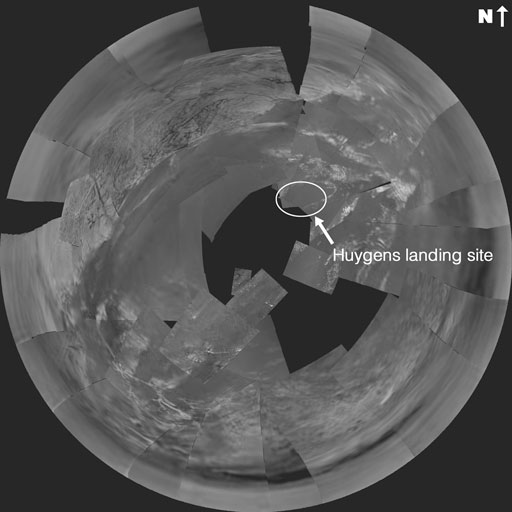Explanation: What did the Huygens probe see as it descended toward Saturn's Moon Titan? In January the robot Cassini spacecraft now orbiting Saturn released a probe through the dense cloud decks of one of the Solar System's most mysterious moons. Below the clouds, as it descended, the probe took images of the approaching surface as well as several images from the surface itself. Many of the images have now been digitally merged and scaled into the above perspective from 3,000 meters high. The above stereographic projection shows a 360-degree wide-angle view of the surface of Titan. The bright areas toward the top and left of the image are thought to be relatively high ground laced with drainage channels cut by rivers of methane. The bright shapes on the right are now hypothesized to be ridges of ice gravel. Huygen's landing site, labeled, appears to be on a type of dark dry lakebed, once fed by a large dark flow channel on the left. The Huygen's probe lasted an unexpectedly long three hours on Titan's harsh surface.
1999 2000 2001 2002 2003 2004 2005 2006 2007 2008 2009 2010 2011 2012 2013 2014 2015 2016 2017 2018 2019 2020 2021 2022 2023 2024 2025 |
Yanvar' Fevral' Mart Aprel' Mai Iyun' Iyul' Avgust Sentyabr' Oktyabr' Noyabr' Dekabr' |
NASA Web Site Statements, Warnings, and Disclaimers
NASA Official: Jay Norris. Specific rights apply.
A service of: LHEA at NASA / GSFC
& Michigan Tech. U.
|
Publikacii s klyuchevymi slovami:
Titan - cassini spacecraft - Huygens probe - Titan - KA Kassini - zond Gyuigens
Publikacii so slovami: Titan - cassini spacecraft - Huygens probe - Titan - KA Kassini - zond Gyuigens | |
Sm. takzhe:
Vse publikacii na tu zhe temu >> | |
